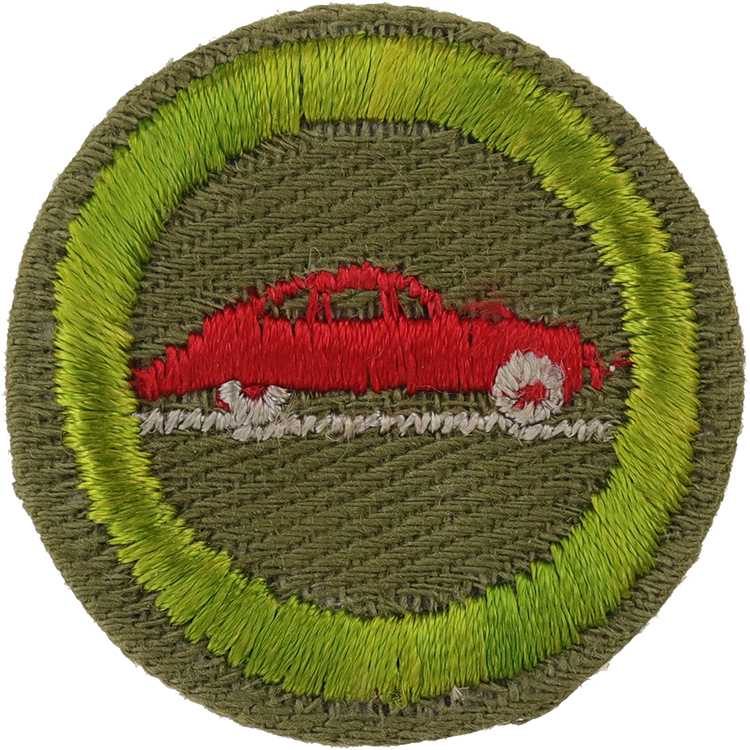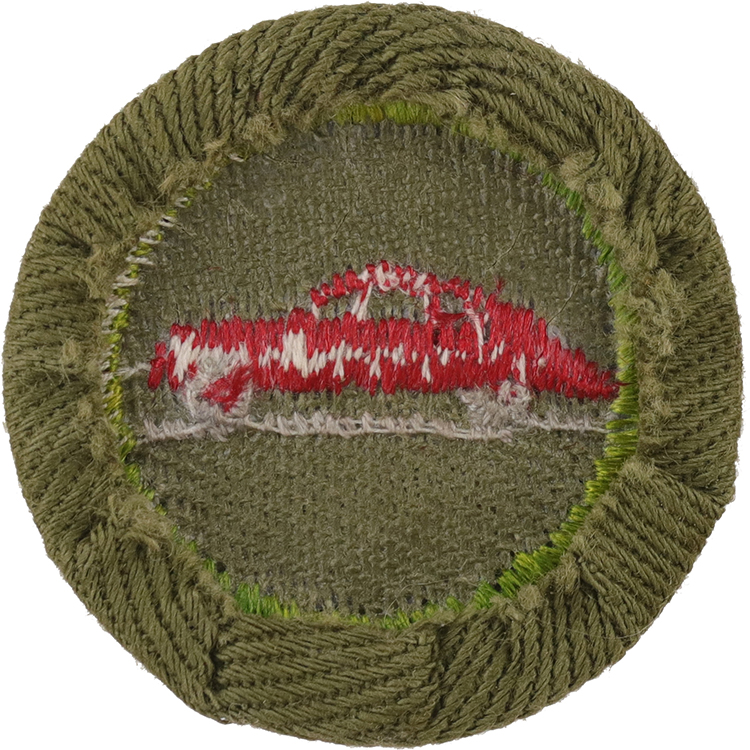
Fig. 1: Automo-E2-Front
- Cloth: Khaki right twill
- Embroidery: Cotton lock stitch

Fig. 2: Automo-E2-Reverse
- Back: Plain NO imprint with starch

Fig. 3: Automo-E2-mve1-front
- Minor variation: Wide light border

Fig. 4: Automo-E2-mve1-reverse
- Back: Plain NO imprint with starch
Item Name: Automobiling 1947 - 1960
Item ID: Automo-E2
Collector Rating: 1
Requirements December 1940 until January 1957
To obtain this Merit Badge a Scout must be of legal age to drive a car and meet all other legal requirements of his state and must:
1. Carefully examine and check the conditions of the following safety features:
(a) Windshield wiper.
(b) Adjustment of rear view mirror.
(c) Highlights for all headlight switch positions. Reflector surfaces. Cleanliness of lenses and that bulbs are free from blackening.
(d) Elevation and focus of headlight beams.
(e) Tail and stop lights.
(f) Windshield and rear window visibility.
(g) “Play” in steering wheel.
(h) Adjustment of brakes.
(I) Tires.
2. (a) List ten important things in his local or state Motor Vehicle Regulations.
(b) Give the necessary qualifications (including age) before a person can legally drive a car in his state.
3. Explain how the use of intoxicating liquor increases motor accidents, as, for example, in its effect on the driver’s vision, judgment and coordination.
4. A driver on dry road, with brakes in good condition, sees danger ahead. Tell how many feet he requires to stop his car going 20 miles an hour; 40 miles; 60 miles.
5. Visit a traffic court (or traffic session of court) or interview a highway traffic officer, and make a report on at least two accident cases. Tell from evidence what driving and safety rules were violated, and how accidents could have been prevented.
6. (a) List at least six sound driving practices which make for safety and courtesy on the road.
(b) List at least four important characteristics of a good driver.
(c) Demonstrate hand signals, using both single hand position and three position systems; explaining their meaning.
7. Explain:
(a) Purpose of clutch, gear shift, accelerator, choke, and brakes; describe briefly how each works.
(b) How to stop a car on wet or icy road.
(c) What to do when end skids to right; to left.
(d) What to do when stop light on rear of car ahead blinks
8. Change a tire.
9. (a) Star a motor; put car in gear; shift gears.
(b) Come smoothly to a full stop from a speed of 30 miles an hour.
(c) Make right and left turns from proper lanes, giving proper signals at proper time.
(d) Park in a 20 foot space.
(e) Start a car after stopping on an up-grade (away from curb); park on an up-grade and on a down-grade. Show how to drive down a steep hill OR show how to get out of sand, mud or snow.
(f) Turn around in order to go in opposite direction between lines or markers 25 feet apart.
10. Show ability to stop a car going at a speed of 20 miles per hour so that nose of car fits into a chalk marked U-shaped box 5 feet wide. Bumpers should be over front line of the box and tires inside of side lines.
Requirements January 1957 until September 1961
Be of legal age to drive a car and meet all other legal requirements of your state.
1. Carefully examine and check the conditions of the following safety features:
(a) Windshield wipers.
(b) Adjustment of rearview mirror.
(c) Highlights for all headlight switch positions.
(d) Elevation and focus of headlight beams.
(e) Tail and stop lights.
(f) Windshield and rear window visibility.
(g) “Play” in steering wheel.
(h) Adjustment of brakes.
(I) Tires.
2. (a) List ten important things in your local or state Motor Vehicle Regulations.
(b) Give the necessary qualifications (including age) before a person can legally drive a car in your state.
3. Explain how the use of intoxicating liquor increases motor accidents, as, for example, in its effect on the driver’s vision, judgment and coordination.
4. A driver on dry road, with brakes in good condition, sees danger ahead. Tell how many feet he requires to stop his car going 20 miles an hour; 40 miles; 60 miles.
5. Visit a traffic court (or traffic session of court) or interview a highway traffic officer, and make a report on at least two accident cases. Tell from evidence what driving and safety rules were violated and how accidents could have been prevented.
6. (a) List at least six sound driving practices which make for safety and courtesy on the road.
(b) List at least four important characteristics of a good driver.
(c) Demonstrate hand signals, using both single hand position and three position systems; explaining their meaning.
7. Explain:
(a) Purpose of clutch, gearshift, accelerator, choke, and brakes; describe briefly how each works.
(b) How to stop car on wet or icy road.
(c) What to do when end skids to right; to left.
(d) What to do when you first notice the shining stop light on the rear of car ahead.
8. Change a tire.
9. (a) Star engine; put car in gear; shift gears.
(b) Come smoothly to a full stop from a speed of 30 miles an hour.
(c) Make right and left turns from proper traffic lanes, giving proper signals at proper time.
(d) Park in a 20 foot space.
(e) Start a car after stopping on an upgrade (away from curb); park on an upgrade and on a downgrade. Show how to drive down a steep hill OR show how to get out of sand, mud or snow.
(f) Turn around in order to go in opposite direction between lines or markers 25 feet apart.
10. Show ability to stop a car going at a speed of 20 miles per hour so that nose of car fits into a chalk-marked U-shaped box 5 feet wide. Bumpers should be over front line of the box and tires inside of side lines.


